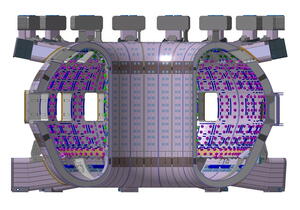ITER and Korea sign Procurement Arrangements for the vacuum vessel
The vacuum vessel is the central part of the ITER machine: a double-walled steel container in which the plasma is contained by means of magnetic fields. Last week, the ITER Organization and the Korean Domestic Agency signed two Procurement Arrangements for the supply of two of the nine sectors of the vacuum vessel and the equatorial and lower ports for all nine sectors. The Procurement Arrangement was signed by the Director-General of the ITER Organization, Kaname Ikeda, and the Director General of the Korean Domestic Agency, Kijung Jung, on the occasion of the third meeting of the ITER Council. The total credit value of these two Procurement Arrangements is ~EUR 116 million.
The ITER vacuum vessel will be the biggest fusion furnace ever built. It will be twice as large and 16 times as heavy as any previously manufactured fusion vessel: each of the nine torus shaped sectors will weigh about 450 tonnes. When all the shielding and port structures are included, this adds up to a total of 5,116 tonnes. Its external diameter will measure 19.4 metre, and the internal diametre: 6.5 m. Once assembled, the whole structure will be 11.3 m high.
The primary function of the vacuum vessel is to provide a hermetically sealed plasma container. Its main components are the main vessel, the port structures and the supporting system. The main vessel is a double walled structure with poloidal and toroidal stiffening ribs between 60 mm thick shells to reinforce the vessel structure. These ribs also form the flow passages for the cooling water. The space between the double walls will be filled with shield structures made of austenitic stainless steel which is corrosion resistant and does not conduct heat well.
The inner surfaces of the vessel will be covered with blanket modules. These modules will provide shielding from the high-energy neutrons produced by the fusion reactions and some will also be used for tritium breeding concepts.
The vacuum vessel has 18 upper, 17 equatorial and 9 lower ports that will be used for remote handling operations, diagnostic systems, neutral beam injections and—last but not least—for vacuum pumping.
The remaining seven sectors of the vacuum vessel will be provided by the European Union according to the ITER principle of baseline procurement sharing. The signature with Europe is anticipated at a later date.


